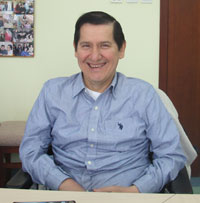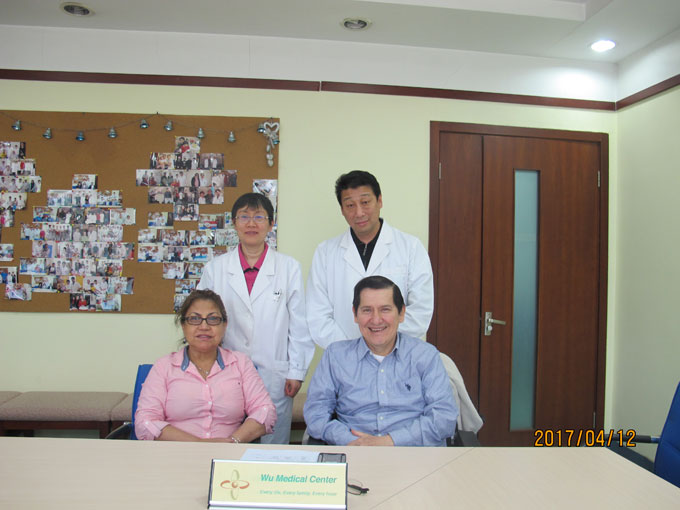Juan Chabla-Amyotrophic Lateral Sclerosis-(America)-Posted on August 18th, 2017
 Name: Juan Chabla
Name: Juan Chabla
Sex: Male
Nationality: American
Age: 59Y
Diagnosis: 1. Amyotrophic Lateral Sclerosis (ALS) 2. Type 2 diabetes 3. Hypertension level 3
Date of Admission: March 29th, 2017
Treatment hospital/period: Wu Medical Center/15 days
Before treatment:
In October 2013 the patient’s family members noticed his abdominal muscle shake followed by the right arm proximal muscle tremor. There was then right leg proximal lateral muscle numbness and pain but it did not affect the daily life of the patient. After that these symptoms continued and he also had muscle weakness and muscle atrophy of his right side limbs. In November 2015 he went to a neurology department and was given the relevant examination. The patient’s condition gradually worsened. The right leg showed difficulty when walking, the right arm lacked lifting strength and his language was unclear. He was diagnosed with Amyotrophic Lateral Sclerosis. Seven months ago it was difficult for him to walk with his left leg failing and he had falls and soon he was completely unable to walk. A month ago the patient's left arm activity was also significantly limited and he was unable to take care of himself at all. He wants a better life so he came to our hospital.
His spirit is good, he has a diabetes diet, his urination and defecation ability are good. He is unable to sleep well due to the pain of the right side and he has occasional mood swings. He has had a history of type 2 diabetes and hypertension for many years.
Admission PE:
Bp: 131/87mmHg, Hr: 74/min, breathing rate: 18/min, body temperature: 36.2 degrees. Nutrition status is normal with normal physical development. There is no injury or bleeding spots of his skin and mucosa, no blausucht, mild throat congestion, and his tonsils have no swelling. Chest develop is normal but chest movement decreased when he breathes and he mainly depends on abdominal respiration. The respiratory sounds in both lungs are lower than normal with no dry or moist rales. The heart beat is low with regular cardiac rhythm and with no obvious murmur in the valves. The abdomen is soft and flat with no masses or tenderness. Liver and spleen cannot be touched below the rib and there was pitting edema of the feet. Sat:93%.
Nervous System Examination:
Patient was alert and mental status was weak with slurred speech. The memory, orientation and calculation ability were normal. Both pupils were equal in size and round, diameter of 2.5mm, react well to light, eyeballs can move freely, his eye convergence was poor. Bilateral forehead wrinkle and nasolabial folds are symmetrical and he can close his eyes powerfully. His tongue is in middle, the tongue movement was slightly clumsy, there is mild tongue muscle atrophy but showing teeth is normal. The patient can bulge the cheeks as normal. Chewing ability is normal and the soft palate can lift as normal. Swallowing function is normal but he chokes occasionally when he drinks, water. The neck muscles show slight weakness and the bilateral shrug muscle power is 2 degrees. Grip force of right hand is 2 degrees, grip force of left hand is 4 degrees. Muscle power of the right arm is 2- degrees, of the left arm is 3 degrees. Muscle power of the right leg is 0-1 degree, of the left leg is 1- degree. Muscle tone of all 4 limbs are lower than normal. Bilateral biceps reflex, triceps reflex and patellar tendon reflex are lower than normal and the radial periosteal reflex and Achilles tendon reflex cannot be induced by examination. Abdominal reflex cannot be induced. There is severe muscle atrophy of the general shoulder and back muscle groups, intercostal muscles, pectoralis major muscles and the 4 limbs muscle groups. The palm-jerk reflex of both sides are negative; sucking reflex of both sides are negative; bilateral Hoffmann sign of both sides cannot be induced, bilateral Babinski sign cannot be induced by examination. The gross measure of bilateral deep and superficial sensitivity are normal. Patient cannot perform the right side finger opposite test, fast alternate movement and finger to nose test as normal because of his weakness. The left little finger cannot perform the finger opposite movement and he cannot do the heel-knee-tibia test. The meningeal irritation sign is negative.
Treatment:
After the admission, he received related examinations and was diagnosed with ALS. He received 3 neural stem cell injections and 3 mesenchymal stem cell injections to repair his damaged nerves, replace dead nerves with new injected stem cells, nourish nerves, regulate his immune system and improve blood circulation. He underwent rehabilitation training.
Post-treatment:
After 15 days treatment his breathing function improved and the blood oxygen saturation increased from 93% to 97%. Muscle power of the left arm is 3+ degrees, left hand grip force is 4+ degree, muscle power of the right arm is 2 degrees right hand grip force is 3 degrees. He is now starting to show an ability to write. His right thumb and index finger can perform the finger opposite movement, right leg muscle power is 2- degrees, muscle power of the left leg is 2 degrees His body condition is better than before.

